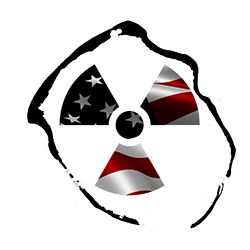Redwing

The Redwing series tests were all named after America Indian tribes. After the serious mishap and contamination that came out of the Bravo test, the power of the Redwing series weapons was kept within what were deemed manageable limits, designed to limit fallout.
The main purpose of Operation Redwing was to test high-yield thermonuclear devices that “could not be tested in Nevada”. Draw from that what you will. The public’s awareness of the effects of fallout was beginning to create problems for the open-air test program on US mainland.
This series proof tested the Mk-28 warhead, a light weight, 20″ diameter thermonuclear design dramatically smaller than most of the Castle designs; the first three-stage thermonuclear systems ever tested; tests of designs intended for both clean, low fall-out and dirty weapons like Bravo. Tests of low yield tactical fission weapons were also conducted, including some very small diameter, lightweight devices with diameters of 5, 8, and 11.6 inches, some of which would go on to be developed as nuclear artillery shells. The first U.S. air drop of a thermonuclear weapon was also conducted during Redwing – partly as a weapons effects test, and partly as a political demonstration of the United States’ capability to conduct nuclear attacks.
 Lacrosse device on board the barge
Lacrosse device on board the barge- LacrosseLacrosse was a 40 kiloton weapon test conducted on May 5, from a platform on the reef just off Runit on the seaward side. In photographs of the Cactus dome, the Lacrosse crater 400ft across and 55 ft deep, can clearly be seen just offshore.
Cherokee
The photo at the top of the page is the Cherokee shot. Cherokee was the only one of the series not expressly for weapons development, which was airdropped from a B-52. Ever wary of the USSR, its primary purpose was to demonstrate the deliverability of large-yield nuclear devices. The 3.8 megaton blast was viewed by 15 press observers, the first civilian group invited to view a Pacific nuclear test since the Crossroads tests at Bikini in 1946. Cherokee marks the first U.S. air drop of a hydrogen weapon, Ivy Mike and Castle Bravo both being surface detonations. This test was intended to gather weapon effects data for high yield air bursts, but also was a demonstration of the United States capability to deliver H-bombs by air to impress the Soviet Union. There was always a tacit understanding that the Soviets were monitoring the tests. They could detect the fallout and knew when they were conducted even if they were unannounced (most were). US warships around the Proving Grounds spent much of their time chasing Soviet submarines out of the area.
The Cherokee device was a TX-15-X1 weapon similar to the lower yield Zombie one tested in the Castle Nectar shot. The B-52 was flown from Enewetak with an intended ground zero directly over Namu Island on Bikini, but a navigating snafu had the weapon detonating 4 miles off target over open ocean, well to the northeast of Namu. Virtually all the weapons effects data was lost as a result.
Zuni
The Bassoon device was the first test ever of a three-stage thermonuclear design and the first successful test of a Lawrence Livermore hydrogen bomb, with a yield of 3.5 megatons. The version fired in this test was a clean, low fallout one that used a lead tamper around the thermonuclear third stage. A high fallout version of this design, the Bassoon Prime device, was later fired in Redwing Tewa. The predicted yield for Zuni was 2-3 megatons. Bassoon measured 39 inches in diameter and was 135.5 inches long. It weighed in at a nimble 12,000 lb. It left a crater 2330 feet wide and 113 feet deep. Bassoon was later used as the basis for the 25 megaton Mk-41, the highest yield weapon ever fielded by the U.S.
Yuma
This was a UCRL linear implosion design intended for air defense warheads. The device, known as Swift, was a boosted asymmetrical design. The device failed to boost however, and the yield was far below predictions, just 0.19 kilotons. The Swift was just 5 inches in diameter, and 24.5 inches long, and weighed 96 lb. This was the smallest diameter, and lightest nuclear device tested up to this time. It used Octol 76/24 as the explosive and was presumably a plutonium-fueled device.

Erie
This was a test of the boosted primary and the implosion system for the TX-28C (“C” for “clean”) thermonuclear bomb. The complete device was small, 20 inches in diameter, 55 inches long, and weighed 2106 lb yet had a yield of 14.9 kilotons.
Seminole
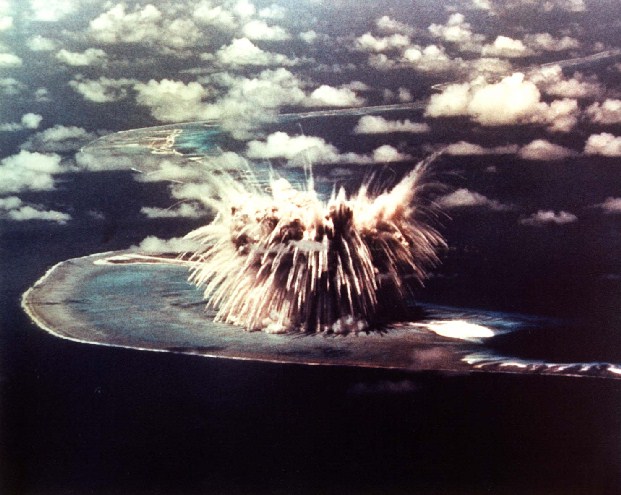 Seminole was one of the most peculiar weapon effects tests ever conducted, as well as one of the most spectacular. The device being tested was a TX-28 primary/implosion system. This was a combined weapons development/effects test in which the device was exploded in a large tank of water to better direct the shockwave to the ground. In effect, the above-ground water tank simulated an underground nuclear test. The device was housed in a circular chamber inside the water tank which was accessible by a corridor through the tank. The 13.7 kiloton blast produced a crater 660 feet wide and 32 feet deep.
Seminole was one of the most peculiar weapon effects tests ever conducted, as well as one of the most spectacular. The device being tested was a TX-28 primary/implosion system. This was a combined weapons development/effects test in which the device was exploded in a large tank of water to better direct the shockwave to the ground. In effect, the above-ground water tank simulated an underground nuclear test. The device was housed in a circular chamber inside the water tank which was accessible by a corridor through the tank. The 13.7 kiloton blast produced a crater 660 feet wide and 32 feet deep.
Flathead
This was a test of the TX-28S. The ‘S’ stands for salted, a dirty high fallout bomb design. The yield was 73% fission. The device was 20 inches by 55 inches and weighed 1374 lb.
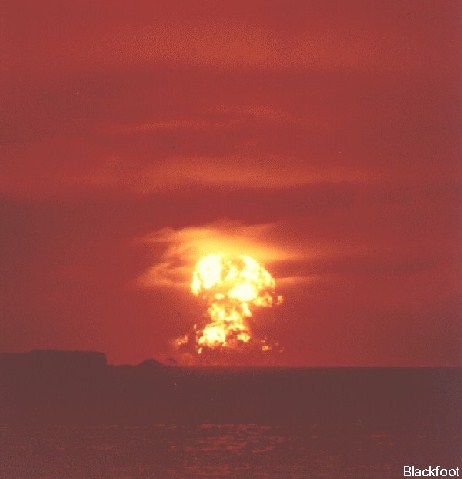 Blackfoot
Blackfoot This LASL test was a prototype of a low-yield, small-diameter, lightweight air defense warhead. The boosted device was the first nuclear test ever to use a PBX (plastic bonded explosive) for the implosion system. The device diameter was only 11.5 inches, which would appear to be about as small as a spherical implosion device can be made. It was 23 inches long, and was light enough for one person to carry – the device’s total weight was 130 lb.
Kickapoo
This was a UCRL linear implosion design intended for air defense warheads. This device, known as Swallow, was a boosted asymmetrical design. The Swallow device was just 8 inches in diameter, and 28 inches long, and weighed 225 lb. This was the smallest diameter, and lightest nuclear device tested up to this time. It used Cyclotol 75/25 as the explosive and was presumably a plutonium-fueled device.
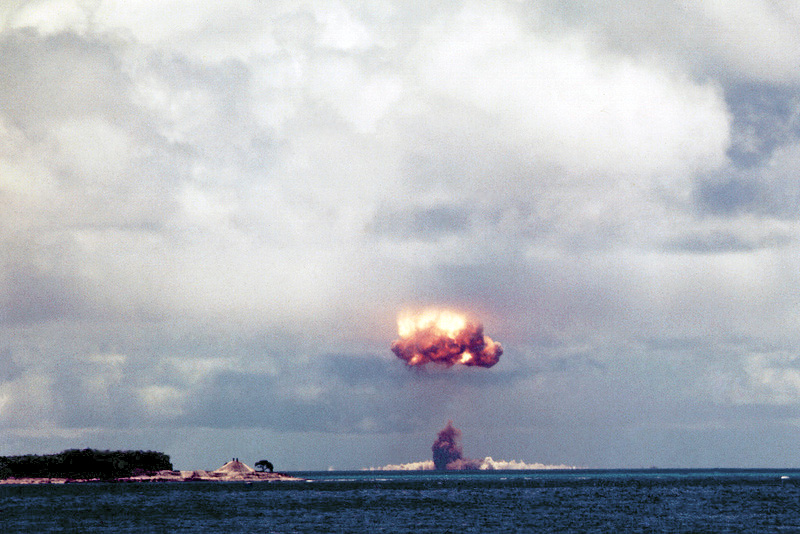
Osage
Proof test of the LASL XW-25 warhead. This was a light weight, low yield, plutonium warhead intended for air defense and other tactical applications. This spherical implosion device had a diameter of 17.4 inches, was 25.7 inches long and weighed 174.6 lb. It was dropped in an instrumented Mk 7 drop case, which had a total weight of 3150 lb.
Inca
UCRL test of a multi-application boosted tactical nuclear warhead prototype named Swan. This design was later developed into the XW-45 warhead. The predicted yield was 10-15 kt.

Dakota
TX-28C variant prototype test. The W-28 small diameter, lightweight thermonuclear weapon design became the most malleable and versatile design ever adopted by the United States. Entering service in 1958, the W-28 remained in service until 1990. It was fielded in 5 models, with 20 variants. The test device was 20 inches in diameter, 58 inches long, and weighed 1797 lb. Test results were substantially better than expected. The predicted yield was 800 kilotons but the final yield was 1.1 megatons. Dakota was fired over the Flathead test site.
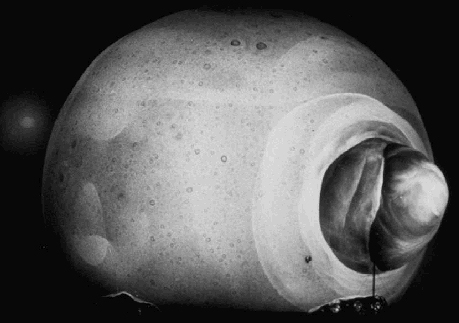 Mohawk
Mohawk This compact University of California Radiological Laboratory thermonuclear device used a boosted “Swan” primary and “Flute” secondary. The device was 15 inches in diameter, 46.2 inches long, and weighed 1116 lb. The yield was at the high end of the predicted range. A wide, very shallow crater was created, 1340 feet in diameter by 8 feet deep.
The picture shows the Mohawk test several hundred microseconds after detonation. The “nipple” at right is the vaporized shot cab
Apache
UCRL test of a two-stage system using a Zither secondary stage. This was a prototype of the XW-27 warhead intended for the Regulus I missile and was fired in a Regulus nose cone. Used the same LASL primary design that was fired in Redwing Lacrosse (40 kt). The test device was 30.2 inches in diameter, 69.8 inches long, and weighed 2941 lb. A high percentage of the yield was due to fission. Apache
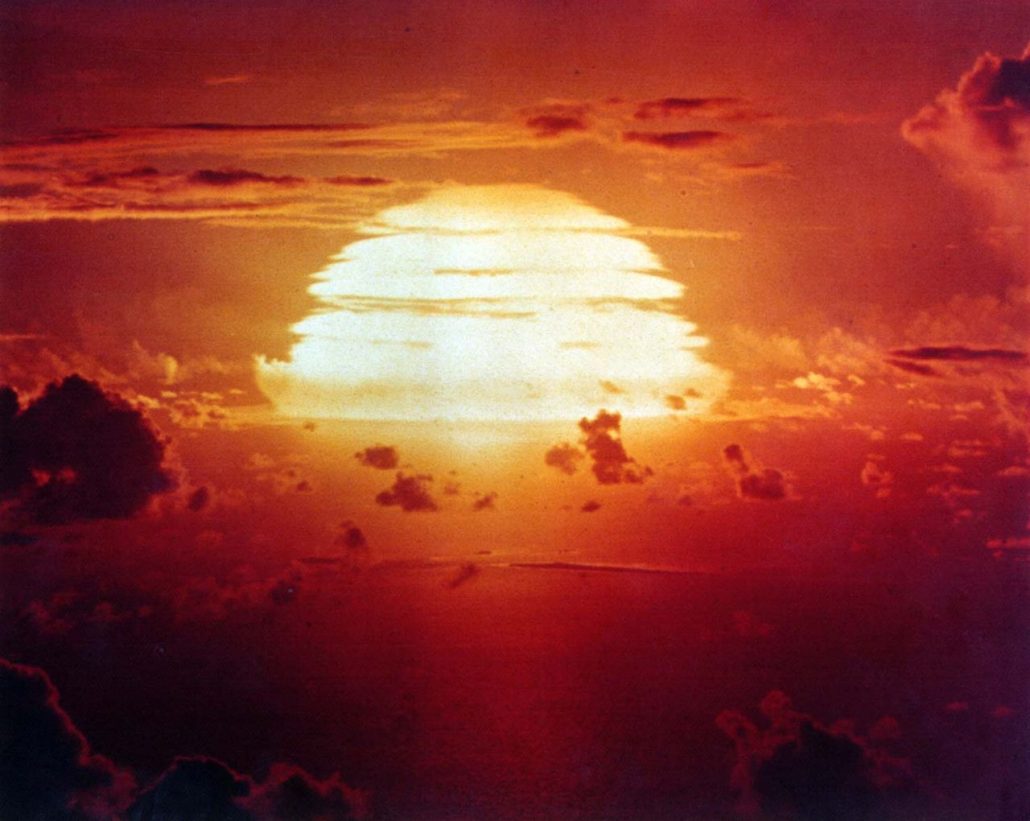
Navajo
LASL test of the TX-21C “clean” thermonuclear device. The yield was 95% fusion, the highest known fusion yield of any U.S. test and thus the cleanest U.S. shot ever fired. Yield was in the predicted range.
Tewa
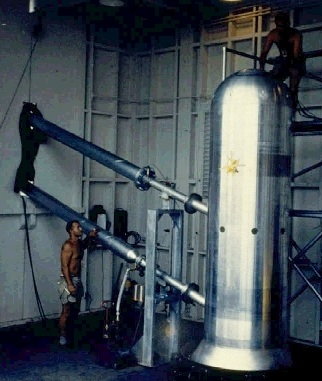 The next-to-last test, Tewa, was launched from a reef at Bikini and had a yield of 5 megatons. Tewa became notable as one of the dirtiest tests of the entire test series and is thought to have irradiated a great many of the personnel nearby. Tewa’s fallout was about 30 percent of its total yield of 5 megatons and contaminated 43,500 nautical miles of ocean, according to “Operation Redwing: Fallout Location and Delineation by Aerial Surveys,” declassified in 1988. This device, the Bassoon Prime, was a deliberately dirty three-stage design. It was the first “triple”. This was actually the second test of this design. The fission yield was 87%, the highest known fission yield in any U.S. thermonuclear test. A uranium tamper was used around the tertiary stage instead of the lead tamper used in Zuni. The predicted yield was 6-8 Mt. Tewa was so powerful it was seen in Honolulu, 2,500 miles away. The device was 39 inches in diameter and 135.5 inches long, and looked like a 15000 lb inverted bassoon. The crater left in the reef was 4000 ft in diameter and 129 ft deep. This design was later developed into the 25 megaton Mk-41, the highest yield weapon ever deployed by the U.S.
The next-to-last test, Tewa, was launched from a reef at Bikini and had a yield of 5 megatons. Tewa became notable as one of the dirtiest tests of the entire test series and is thought to have irradiated a great many of the personnel nearby. Tewa’s fallout was about 30 percent of its total yield of 5 megatons and contaminated 43,500 nautical miles of ocean, according to “Operation Redwing: Fallout Location and Delineation by Aerial Surveys,” declassified in 1988. This device, the Bassoon Prime, was a deliberately dirty three-stage design. It was the first “triple”. This was actually the second test of this design. The fission yield was 87%, the highest known fission yield in any U.S. thermonuclear test. A uranium tamper was used around the tertiary stage instead of the lead tamper used in Zuni. The predicted yield was 6-8 Mt. Tewa was so powerful it was seen in Honolulu, 2,500 miles away. The device was 39 inches in diameter and 135.5 inches long, and looked like a 15000 lb inverted bassoon. The crater left in the reef was 4000 ft in diameter and 129 ft deep. This design was later developed into the 25 megaton Mk-41, the highest yield weapon ever deployed by the U.S.The Bassoon Prime device being installed in its “shot cab”. Two diagnostic “light pipes” are visible which transmit data to monitoring equipment in the microseconds before they’re destroyed.
Huron
A Los Alamos Scientific Labs two stage Egg device, diameter 15.3 inches, length 43.1 inches, weight 793 lb. Used PBX-9401 and PBX-9404 explosives. Huron matched its predicted yield. It was a possible XW-50 prototype.
Lewis Strauss, head of the Atomic Energy Commission, issued a brief statement about the results of Redwing tests … In his words, the tests had achieved “maximum effect in the immediate area of a target with minimum widespread fallout hazard.” … Strauss concluded hopefully that Redwing had proven “much of importance not only from a military point of view but from a humanitarian aspect.” Strauss had a very broad threshold wherever fallout was concerned. His “minimum” has to be looked at in a historical context and with foreknowledge of statements regarding the issue in years prior. Any amount of fallout seems to have been acceptable as long as research was advanced.
- Lewis L. Strauss, quoted in Atoms for Peace and War 1953-1961, Richard G. Hewlett and Jack M. Holl.
| Shot Name | Firing Time and Date (GMT) | Yield – Actual (Predicted) |
|---|---|---|
| Lacrosse | 18:25 May 4, 1956 | 40 kilotons (25-50 kilotons) |
| Cherokee | 17:51 May 20, 1956 | 3.8 Megatons |
| Zuni | 17:56 May 27, 1956 | 3.5 Megatons (2-3 Megatons) |
| Yuma | 19:56 May 27, 1956 | 0.19 kilotons |
| Erie | 18:15 May 30, 1956 | 14.9 kilotons |
| Seminole | 00:55 June 6, 1956 | 13.7 kilotons (10 kilotons) |
| Flathead | 18:26 June 11, 1956 | 365 kilotons |
| Blackfoot | 18:26 June 11, 1956 | 8 kilotons |
| Kickapoo | 23:26 June 13, 1956 | 1.49 kilotons |
| Osage | 01:14 June 16, 1956 | 1.7 kilotons |
| Inca | 21:26 June 21, 1956 | 15.2 kilotons (10-15 kilotons) |
| Dakota | 18:06 June 25, 1956 | 1.1 Megatons (800 kilotons) |
| Mohawk | 18:06 July 2, 1956 | 360 kilotons |
| Apache | 18:06 July 8, 1956 | 1.85 Megatons |
| Navajo | 17:56 July 10, 1956 | 4.5 Megatons |
| Tewa | 17:46 July 20, 1956 | 5 Megatons (6-8 Megatons) |
| Huron | 18:12 July 21, 1956 | 250 kilotons |
